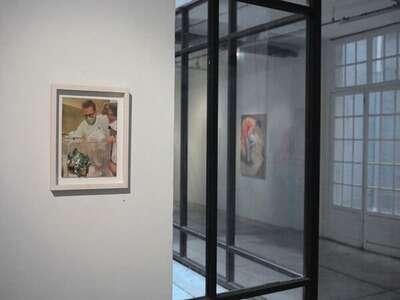CEREMONY INTERRUPTED
OCTOBER 9 - OCTOBER 31, 2014
The unconscious lacks of structure except to the extent that it speaks and is language. There is no structure of bodies except to the extent that bodies are supposed in some way to "speak" with a language that makes a symptom, which is the language of symptoms. Things themselves in general have no structure except to the extent that they support a silent "discourse", which is the language of signs.
1.Deleuze
In Lacan's psychoanalysis the unconscious is structured as a language through metaphorical and metonymic processes; categories of substitution and association in order to refer or enunciate the objects. Meanwhile the triad of the real, the imaginary and the symbolic, constitute the three dimensions knotted in the constitution of the subject. Under this scheme of representation and subjective constitution we can frame the creative process of Daniel Horowitz, who through his work - which on this occasion includes painting, graphic installation, 3D collage, intervention on site and video animation - inscribes the possibility of producing the unrepresentable real, according to the afore mentioned scheme, designing altered realities in which he himself identifies his other self, outside of himself, configuring new symbolic conjectures as hybrids; where his assimilation process at the beginning of the work, the procedural and the definitive suggest, at the end, a fourth moment of symbolic production, that of the spectator.
For this exhibition Horowitz seizes up elements taken from Mexican society and interprets them, based on his personal experience, as a ritualized daily life with deep-rooted patterns of behavior, habits and customs. Ceremonies that burst, according to the artist, in the symbolic imaginary in front of the universe of images in contemporary modernity. In addition to the dialectical principle that he suggests with the viewer, it is worth mentioning that the surfaces or papers that he uses as canvas also acquire a fundamental place in his creative process, since they are never shown passively or as an initial target. Surfaces, as in this case with wood, gallery walls, paper and old book clippings on which he paints and articulates his artistic discourse, always include prior information that interacts with the theme of the work in progress, in a kind of conceptual and plastic collage at the same time. In this way, his work is presented as a way of interpreting the messages of the unconscious, drives that, beyond intuition, lack objects of specific representation, inciting different reactions in each subject to the work. His work speaks of the possibility of producing the real through languages that justify, at the same time, his critical discourse projected on images loaded with information, usually using vintage aesthetics as a compositional element, in the exercise of symbolic relationship. And where the objects of daily use, as well as the figures in the imaginary delineate the surreal nature of the unconscious, under the symbolic surplus of the image produced, becoming the language of signs.
No hay estructura del inconsciente más que en la medida en que el inconsciente habla y es lenguaje. No hay estructura de los cuerpos más que en la medida en que los cuerpos se supone de algún modo que “hablan” con un lenguaje que hace síntoma, que es el lenguaje de los síntomas. Las cosas mismas en general no tienen estructura sino en la medida en que sostienen un “discurso” silencioso, que es el lenguaje de los signos.
1.Deleuze
En el psicoanálisis de Lacan el inconsciente está estructurado como un lenguaje mediante procesos de tipo metafórico y metonímico; categorías de sustitución y asociación con la finalidad de referir o enunciar los objetos. Mientras la triada de lo real, lo imaginario y lo simbólico, constituyen las tres dimensiones anudadas en la constitución del sujeto. Bajo este esquema de representación y constitución subjetiva podemos enmarcar el proceso creativo de Daniel Horowitz, quien a través de su obra, – que en esta ocasión incluye pintura, instalación gráfica, collage 3D, intervención en sitio y video animación-, inscribe la posibilidad de producir lo real irrepresentable, según el esquema citado, diseñando realidades alteradas en las que él mismo identifica su otro yo fuera de él, configurando nuevas conjeturas simbólicas como híbridos; donde su proceso de asimilación al iniciar la obra, el procesual y el definitivo sugieren, al final, un cuarto momento de producción simbólica, el del espectador.
Para esta exhibición Horowitz retoma elementos extraidos de la sociedad mexicana y los interpreta, a partir de su experiencia personal, como una cotidianidad ritualizada con patrones de conducta, usos y costumbres arraigadas. Ceremonias que irrumpen, a decir del artista, en el imaginario simbólico frente al universo de imágenes en la modernidad contemporánea. Aunado al principio dialéctico que sugiere con el espectador, cabe mencionar que las superficies o papeles que usa de lienzos, también adquieren un lugar fundamental en su proceso creativo, pues éstas nunca se muestran de manera pasiva ni como un blanco inicial. Las superficies, como en este caso sucede con la madera, los muros de la galería, el papel y los recortes de libros antiguos sobre los que pinta y articula su discurso artístico, siempre incluyen información previa que interactúa con el tema de la obra en proceso, en una suerte de collage conceptual y plástico al mismo tiempo. De esta manera, su trabajo se presenta como una forma de interpretar los mensajes del inconsciente, pulsiones que más allá de la intuición, carecen de objetos de representación específica, incitando reacciones distintas en cada sujeto frente a la obra. Su trabajo habla de esa posibilidad de producir lo real mediante lenguajes que justifican, al mismo tiempo, su discurso crítico proyectado en imágenes cargadas de información, usualmente utilizando la estética vintage como un elemento de composición, en su ejercicio de relación simbólica. Y donde los objetos de uso cotidiano, así como las figuras en el imaginario delinean la naturaleza surrealista del inconsciente, bajo el excedente simbólico de la imagen producida, deviniendo en lenguaje de los signos.


















